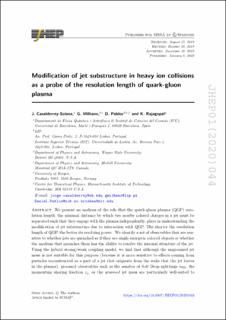| dc.contributor.author | Casalderrey-Solana, J. | |
| dc.contributor.author | Milhano, G. | |
| dc.contributor.author | Pablos Alfonso, Daniel | |
| dc.contributor.author | Rajagopal, K. | |
| dc.date.accessioned | 2021-08-02T11:04:57Z | |
| dc.date.available | 2021-08-02T11:04:57Z | |
| dc.date.created | 2020-10-01T16:19:37Z | |
| dc.date.issued | 2020 | |
| dc.identifier.issn | 1126-6708 | |
| dc.identifier.uri | https://hdl.handle.net/11250/2765827 | |
| dc.description.abstract | We present an analysis of the role that the quark-gluon plasma (QGP) resolution length, the minimal distance by which two nearby colored charges in a jet must be separated such that they engage with the plasma independently, plays in understanding the modification of jet substructure due to interaction with QGP. The shorter the resolution length of QGP, the better its resolving power. We identify a set of observables that are sen- sitive to whether jets are quenched as if they are single energetic colored objects or whether the medium that quenches them has the ability to resolve the internal structure of the jet. Using the hybrid strong/weak coupling model, we find that although the ungroomed jet mass is not suitable for this purpose (because it is more sensitive to effects coming from particles reconstructed as a part of a jet that originate from the wake that the jet leaves in the plasma), groomed observables such as the number of Soft Drop splittings nSD, the momentum sharing fraction zg, or the groomed jet mass are particularly well-suited to discriminate the degree to which the QGP medium resolves substructure within a jet. In order to find the optimal grooming strategy, we explore different cuts in the Lund plane that allow for a clear identification of the regions of Soft Drop phase space that enhance the differences in the jet substructure between jets in vacuum and quenched jets. Comparison with present data seems to disfavor an “infinite resolution length”, which is to say the hypothesis that the medium interacts with the jet as if it were a single energetic colored object. Our analysis indicates that as the precision of experimental measurements of jet substructure observables and the control over uncertainties in their calculation improves, it will become possible to use comparisons like this to constrain the value of the resolution length of QGP, in addition to seeing how the substructure of jets is modified via their passage through it. | en_US |
| dc.language.iso | eng | en_US |
| dc.publisher | Springer | en_US |
| dc.rights | Navngivelse 4.0 Internasjonal | * |
| dc.rights.uri | http://creativecommons.org/licenses/by/4.0/deed.no | * |
| dc.title | Modification of jet substructure in heavy ion collisions as a probe of the resolution length of quark-gluon plasma | en_US |
| dc.type | Journal article | en_US |
| dc.type | Peer reviewed | en_US |
| dc.description.version | publishedVersion | en_US |
| dc.rights.holder | Copyright 2020 The Authors | en_US |
| dc.source.articlenumber | 44 | en_US |
| cristin.ispublished | true | |
| cristin.fulltext | original | |
| cristin.qualitycode | 2 | |
| dc.identifier.doi | 10.1007/JHEP01(2020)044 | |
| dc.identifier.cristin | 1836368 | |
| dc.source.journal | Journal of High Energy Physics (JHEP) | en_US |
| dc.identifier.citation | Journal of High Energy Physics (JHEP). 2020, 2020, 44 | en_US |
| dc.source.volume | 2020 | en_US |

